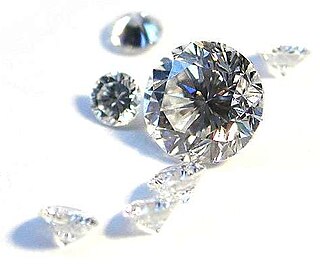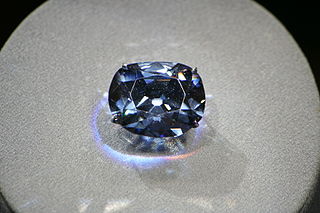Related Research Articles

The Hope Diamond is a 45.52-carat (9.104 g) diamond originally extracted in the 17th century from the Kollur Mine in Guntur, India. It is blue in color due to trace amounts of boron. Its exceptional size has revealed new information about the formation of diamonds.
The Deepdene is a 104.52 carats (20.904 g) yellow diamond widely considered to be the largest irradiated diamond in the world.

The Allnatt Diamond is a diamond measuring 101.29 carats with a cushion cut, rated in color as Fancy Vivid Yellow by the Gemological Institute of America. This diamond was named after one of its holders, Major Alfred Ernest Allnatt, a soldier, sportsman, art patron and benefactor.

A chemically pure and structurally perfect diamond is perfectly transparent with no hue, or color. However, in reality almost no gem-sized natural diamonds are absolutely perfect. The color of a diamond may be affected by chemical impurities and/or structural defects in the crystal lattice. Depending on the hue and intensity of a diamond's coloration, a diamond's color can either detract from or enhance its value. For example, most white diamonds are discounted in price when more yellow hue is detectable, while intense pink diamonds or blue diamonds can be dramatically more valuable. Of all colored diamonds, red diamonds are the rarest. The Aurora Pyramid of Hope displays a spectacular array of naturally colored diamonds, including red diamonds.

The Gemological Institute of America (GIA) is a nonprofit institute based in Carlsbad, California. It is dedicated to research and education in the field of gemology and the jewelry arts. Founded in 1931, GIA's mission is to protect buyers and sellers of gemstones by setting and maintaining the standards used to evaluate gemstone quality. The institute does so through research, gem identification and diamond grading services and a variety of educational programs. Through its library and subject experts, GIA acts as a resource of gem and jewelry information for the trade, the public and media outlets.
The Heart of Eternity is a diamond measuring 27.64 carats, rated in color as "Fancy Vivid Blue" by the Gemological Institute of America. The Heart of Eternity was cut by the Steinmetz Group, who owned the diamond before selling it to the De Beers Group.
The Moussaieff Red Diamond is a diamond measuring 5.11 carats with a triangular brilliant cut, rated in color as Fancy Red by the Gemological Institute of America. It is the world's largest known red diamond, the rarest of them all.
The Ocean Dream is a diamond measuring 5.51 carats, rated in color as Fancy Deep Blue-Green by the Gemological Institute of America. The Ocean Dream is the first and one of the only natural diamonds known to the GIA to possess a blue-green hue, making it one of the rarest diamonds in the world. (A blue-green colour is commonly seen in artificially enhanced diamonds, whose colour is imparted by various irradiation methods. The Ocean Dream originated in Central Africa, and is currently owned by the Cora Diamond Corporation.
The Pink Star, formerly known as the Steinmetz Pink, is a diamond weighing 59.60 carat, rated in color as Fancy Vivid Pink by the Gemological Institute of America. The Pink Star was mined by De Beers in 1999 in South Africa, and weighed 132.5 carat in the rough. The Pink Star is the largest known diamond having been rated Vivid Pink. As a result of this exceptional rarity, the Beny Steinmetz Group called Steinmetz Diamonds took a cautious 20 months to cut the Pink. It was unveiled in Monaco on 29 May 2003 in a public ceremony.
The De Beers Centenary Diamond is, at 273.85 carats (54.770 g), the third-largest diamond to have been produced in the Premier Mine. Among top-color diamonds, only the Cullinan I and II are larger than the Centenary diamond. The Centenary Diamond is rated in color as grade D color by the Gemological Institute of America, which is the highest grade of colourless diamond and is internally and externally flawless. It was named the Centenary Diamond as it was presented in the rough for the Centennial Celebration of De Beers Consolidated Mines on 11 May 1988. The Centenary Diamond was unveiled in final form in May 1991.
The Great Chrysanthemum Diamond is a famous diamond measuring 104.15 carats with a pear-shaped modified brilliant cut, rated in colour as Fancy Orange-Brown and I1 clarity by the Gemological Institute of America. The Great Chrysanthemum is roughly the same size as the re-cut Kohinoor and almost three times the size of the Hope Diamond, The Great Chrysanthemum has the dimensions of 39.10 x 24.98 x 16.00 mm. and features 67 facets on the crown, 57 facets on the pavilion and 65 vertical facets along the girdle. The diamond, designed as a pendant, became the central focus of a necklace with 410 oval, pear-shaped, round and marquis diamonds.

Harry Winston was an American jeweler. He donated the Hope Diamond to the Smithsonian Institution in 1958 after owning it for a decade. He also traded the Portuguese Diamond to the Smithsonian in 1963 in exchange for 3,800 carats of small diamonds.

Diamond is one of the best-known and most sought-after gemstones. They have been used as decorative items since ancient times.

Brown diamonds are the most common color variety of natural diamonds. In most mines, brown diamonds account for 15% of production. The brown color makes them less attractive to some people as gemstones, and most are used for industrial purposes. However, improved marketing programs, especially in Australia and the United States, have resulted in brown diamonds becoming valued as gemstones and even referred to as chocolate diamonds.
Graff is a British multinational jeweller based in London. It was founded by British jeweller Laurence Graff in 1960. A vertically integrated company, Graff operations comprise the design, manufacture and retail distribution of jewellery and watches.

The Ocean Paradise is a diamond measuring 1.6 carats after polish and was discovered in Brazil and currently owned by the Nahshonov Group. When discovered, it measured 6.43 carats. The Ocean Paradise is the second and one of the only natural diamonds known to the GIA to possess a blue-green hue, making it one of the rarest diamonds in the world.
The Winston Blue is the name given to what was the largest flawless vivid blue diamond bought by Harry Winston, Inc. on May 15, 2014, from an anonymous person for $23.8 million at Christie's Geneva Magnificent Jewels sale. The approximately $1.8003 million per carat price paid for the 13.22-carat diamond is a world record for a blue diamond. Harry Winston, Inc. had also bought a 101.73-carat colorless diamond named Winston Legacy at Christie's Geneva jewelry auction in 2013. The American luxury jeweler had then paid $26.7 million for the colorless diamond, which is a world record for the highest price paid per carat for a colorless diamond.

Blue diamond is a type of diamond which exhibits all of the same inherent properties of the mineral except with the additional element of blue color in the stone. They are colored blue by trace amounts of boron that contaminate the crystalline lattice structure. Blue diamonds belong to a subcategory of diamonds called fancy color diamonds, the generic name for diamonds that exhibit intense color.

Pink diamond is a type of diamond that has pink color. The source of their pink color is greatly debated in the gemological world but it is most commonly attributed to plastic deformation that these diamonds undergo during their formation.

A red diamond is a diamond which displays red colour and exhibits the same mineral properties as colourless diamonds. Red diamonds are commonly known as the most expensive and the rarest diamond colour in the world, even more so than pink or blue diamonds, as very few red diamonds have been found. Red diamonds, just like pink diamonds, are greatly debated as to the source of their colour, but the gemological community most commonly attributes both colours to gliding atoms in the diamond's structure as it undergoes enormous pressure during its formation. Red diamonds are among the 12 colours of fancy colour diamonds, and have the most expensive price per carat. They will typically run in the hundreds of thousands of dollars per carat range. Since they are the rarest colour, it is difficult to find them in large sizes, and they are mostly found in sizes less than 1 carat. Red diamonds only exist with one colour intensity, Fancy, although their clarities can range from Flawless to Included, just like white diamonds. The largest and most flawless red diamond is the 5.11 carat Fancy Red Moussaieff Red Diamond, which has internally flawless clarity.
References
- 1 2 Smithsonian Institution. "The Splendor of Diamonds". Retrieved on July 14, 2014.